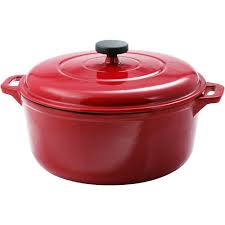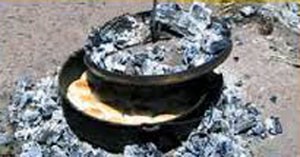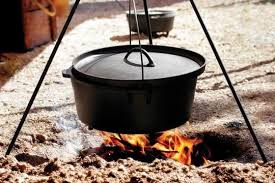Summer is here and now is time to get out the Dutch Ovens and learn to cook with them. Dutch ovens were widely used by the pioneers due to their versatility. If you don’t have one in your preps you need to purchase one. We have several, most of which have come from garage sales.
Here are some guidelines on buying a Dutch oven
- Avoid ones that are made in China, your best bet is to find an old one in a garage sale, an
old Griswold or Wagner would be a great find. If you have to purchase a new one, get a Lodge. I believe they are still made in Tennessee.
- Dutch ovens range in size from eight to about sixteen inches in diameter. The most common size is twelve inches which holds about eight quarts. This size will serve six to eight people.
- Buy only Dutch ovens with legs. There should be three legs, firmly attached. The legs allowed the chef to place the oven on a bed of coals, while the lid and the rim encircling it was designed to hold even more coals on top, so the food inside the oven could be heated from above and below.
- The lid should fit tight with no gaps around the rim and have a vertical lip around the top to hold hot coals.
- The casting and thickness of the metal should be even, especially around the rim. Large variations will create hot and cold spots during cooking.
- Make sure the lid has a loop handle tightly attached to its center.
- The bail or wire handle should be attached firmly to the pot. The bail should be easily movable and strong enough to carry or support a heavy pot full of stew.
- They come in both aluminum and cast iron. The aluminum twelve inch weighs about seven pounds. The cast iron twelve inch weighs approximately 18 pounds.

These work fine on a stove, but are not designed for outdoors
How to choose between aluminum and cast iron. Aluminum reflects heat well and as a result requires more coals than the cast iron to produce the same amount of heat. Aluminum Dutch ovens allow more variation in temperature during windy or cold weather. The only real advantage to the aluminum one is the weight. For backpacking or canoe trips, aluminum may be your best choice. For normal use the cast iron ones are the best. They use less fuel and have a more even heat, and yes the food tastes better.


I am always looking for good Dutch oven recipes, do you have any you wish to share. In the near future we will post articles on seasoning and using Dutch ovens.
Howard


Howard
You said “This is the style of Dutch oven you want for outdoor cooking” (i.e. the one with 3 legs and a rim on the lid for retaining coals.)
This is true IF you want to bake things with a crust on top (such as many types of bread) – for this you need a hot lid and a cooler bottom. However, this type Dutch oven requires a supply of charcoal briquettes or purchased charcoal in bags or a way to make your own charcoal. Many campfire type fire woods do not produce useable coals or require the consumption of what might be an excessive amount of wood to make your own lid heating coals.
A better choice of ovens IF you want to braise things such as a pot roast, is a “stove top” type Dutch oven (i.e., one without legs) and a lid has no coals retaining rim but does have conical nipples or projections on its inner side. The cones collect the drops of moisture that condense on the inside of the unheated lid and allow then to drop onto the food being cooked rather than running off to the outer edge of the lid’s inner surface. I baked a mighty fine pan of cornbread a few nights ago on an outdoor wood fire using one of these ovens equipped with a homemade trivet in its bottom to allow circulation of air under the baking pan. It had a delightful crispy but not burned crust on its bottom.
For me, I use both types of Dutch ovens in various sizes for my outdoor cooking.
Lodge cast iron has a website and I recently purchased another of their products.
Hangtown Frank
I use my dutch oven on the surface of my woodstove. I have the type with a flat bottom and it works well to cook in and I’ve baked inside by raising the baking pan off the bottom surface with a metal trivet. Here’s a link to a pineapple upside-down cake I made. – Margy
https://powellriverbooks.blogspot.ca/2007/04/dutch-oven-pineapple-upside-down-cake.html